Principle of Strategic Communication
VerifiedAdded on 2022/08/26
|11
|2632
|20
AI Summary
Contribute Materials
Your contribution can guide someone’s learning journey. Share your
documents today.
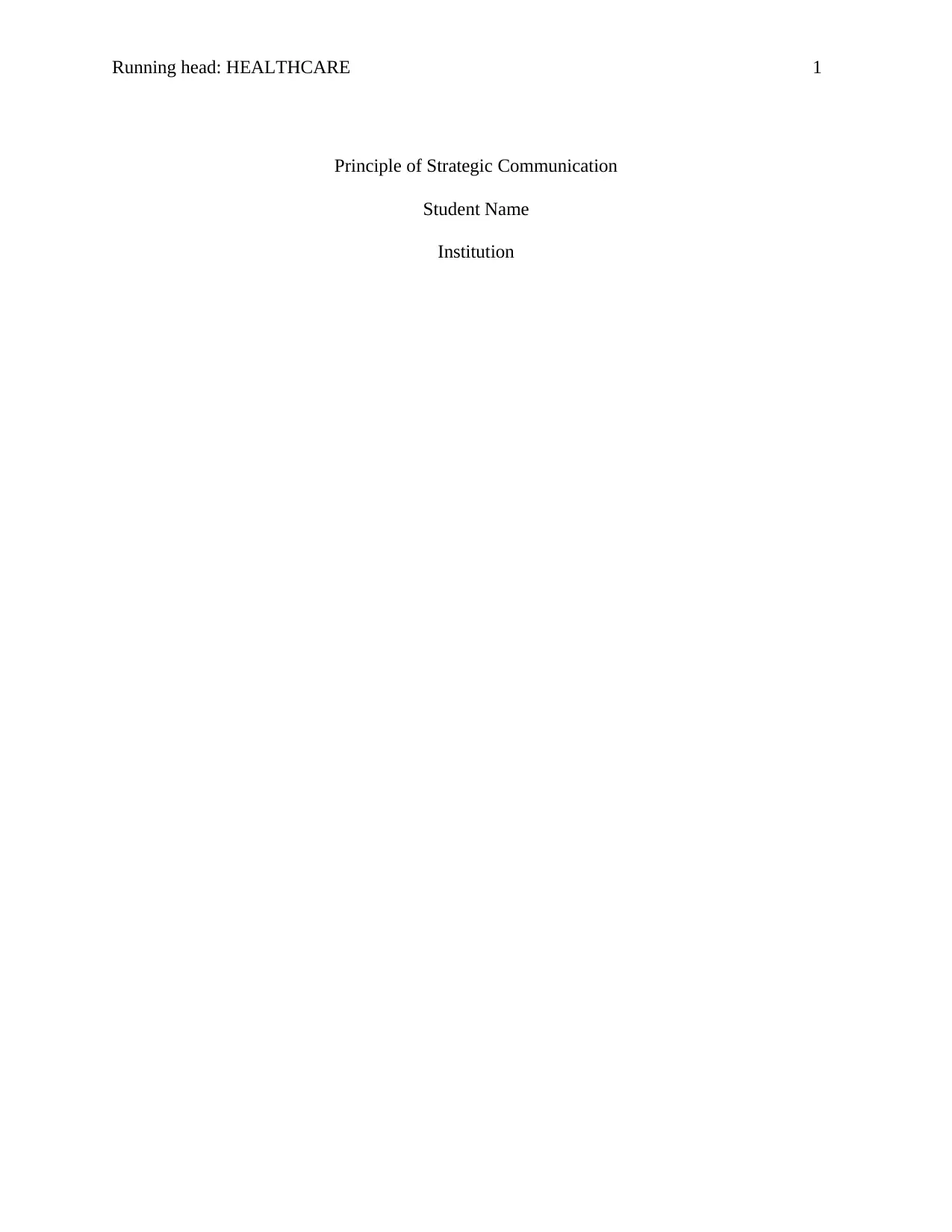
Running head: HEALTHCARE 1
Principle of Strategic Communication
Student Name
Institution
Principle of Strategic Communication
Student Name
Institution
Secure Best Marks with AI Grader
Need help grading? Try our AI Grader for instant feedback on your assignments.
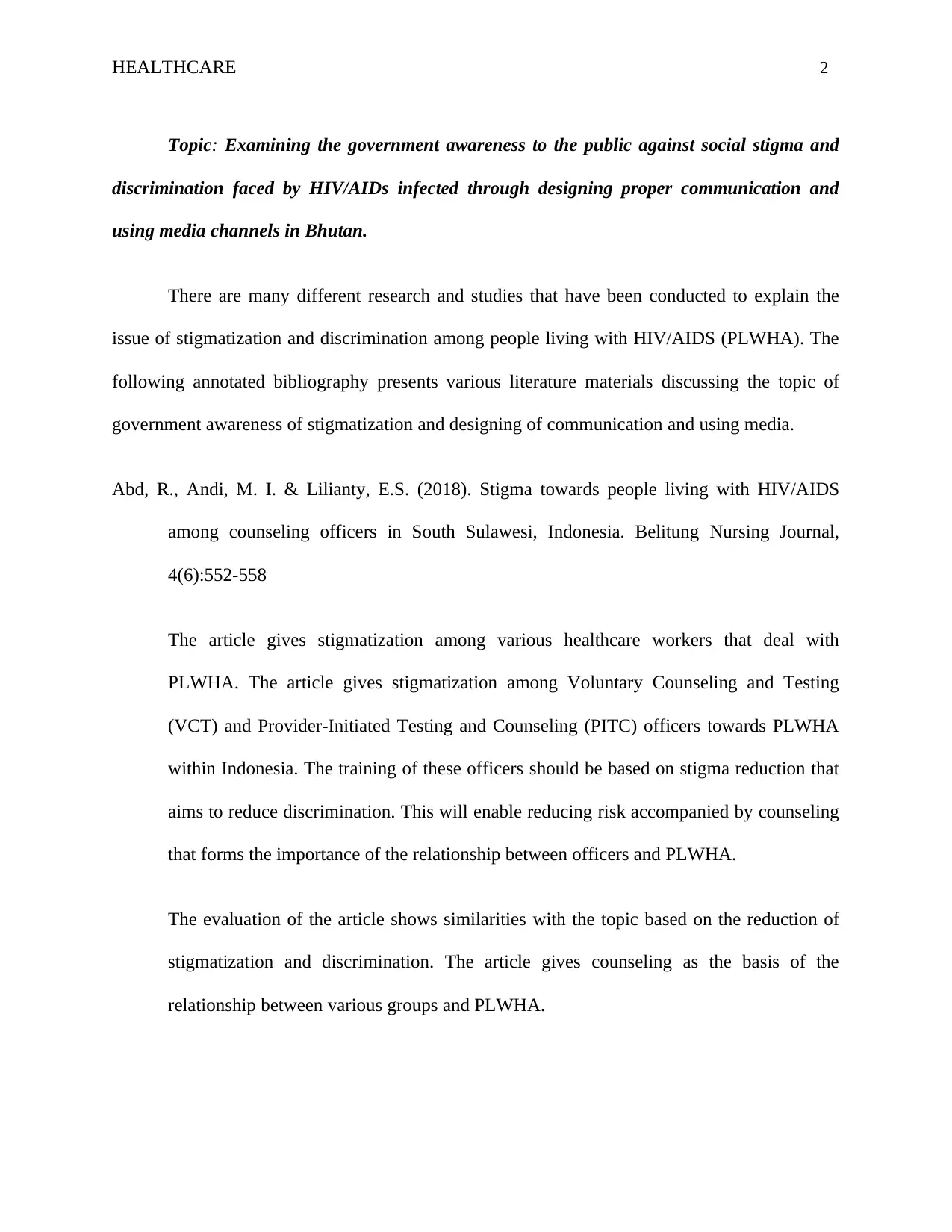
HEALTHCARE 2
Topic: Examining the government awareness to the public against social stigma and
discrimination faced by HIV/AIDs infected through designing proper communication and
using media channels in Bhutan.
There are many different research and studies that have been conducted to explain the
issue of stigmatization and discrimination among people living with HIV/AIDS (PLWHA). The
following annotated bibliography presents various literature materials discussing the topic of
government awareness of stigmatization and designing of communication and using media.
Abd, R., Andi, M. I. & Lilianty, E.S. (2018). Stigma towards people living with HIV/AIDS
among counseling officers in South Sulawesi, Indonesia. Belitung Nursing Journal,
4(6):552-558
The article gives stigmatization among various healthcare workers that deal with
PLWHA. The article gives stigmatization among Voluntary Counseling and Testing
(VCT) and Provider-Initiated Testing and Counseling (PITC) officers towards PLWHA
within Indonesia. The training of these officers should be based on stigma reduction that
aims to reduce discrimination. This will enable reducing risk accompanied by counseling
that forms the importance of the relationship between officers and PLWHA.
The evaluation of the article shows similarities with the topic based on the reduction of
stigmatization and discrimination. The article gives counseling as the basis of the
relationship between various groups and PLWHA.
Topic: Examining the government awareness to the public against social stigma and
discrimination faced by HIV/AIDs infected through designing proper communication and
using media channels in Bhutan.
There are many different research and studies that have been conducted to explain the
issue of stigmatization and discrimination among people living with HIV/AIDS (PLWHA). The
following annotated bibliography presents various literature materials discussing the topic of
government awareness of stigmatization and designing of communication and using media.
Abd, R., Andi, M. I. & Lilianty, E.S. (2018). Stigma towards people living with HIV/AIDS
among counseling officers in South Sulawesi, Indonesia. Belitung Nursing Journal,
4(6):552-558
The article gives stigmatization among various healthcare workers that deal with
PLWHA. The article gives stigmatization among Voluntary Counseling and Testing
(VCT) and Provider-Initiated Testing and Counseling (PITC) officers towards PLWHA
within Indonesia. The training of these officers should be based on stigma reduction that
aims to reduce discrimination. This will enable reducing risk accompanied by counseling
that forms the importance of the relationship between officers and PLWHA.
The evaluation of the article shows similarities with the topic based on the reduction of
stigmatization and discrimination. The article gives counseling as the basis of the
relationship between various groups and PLWHA.
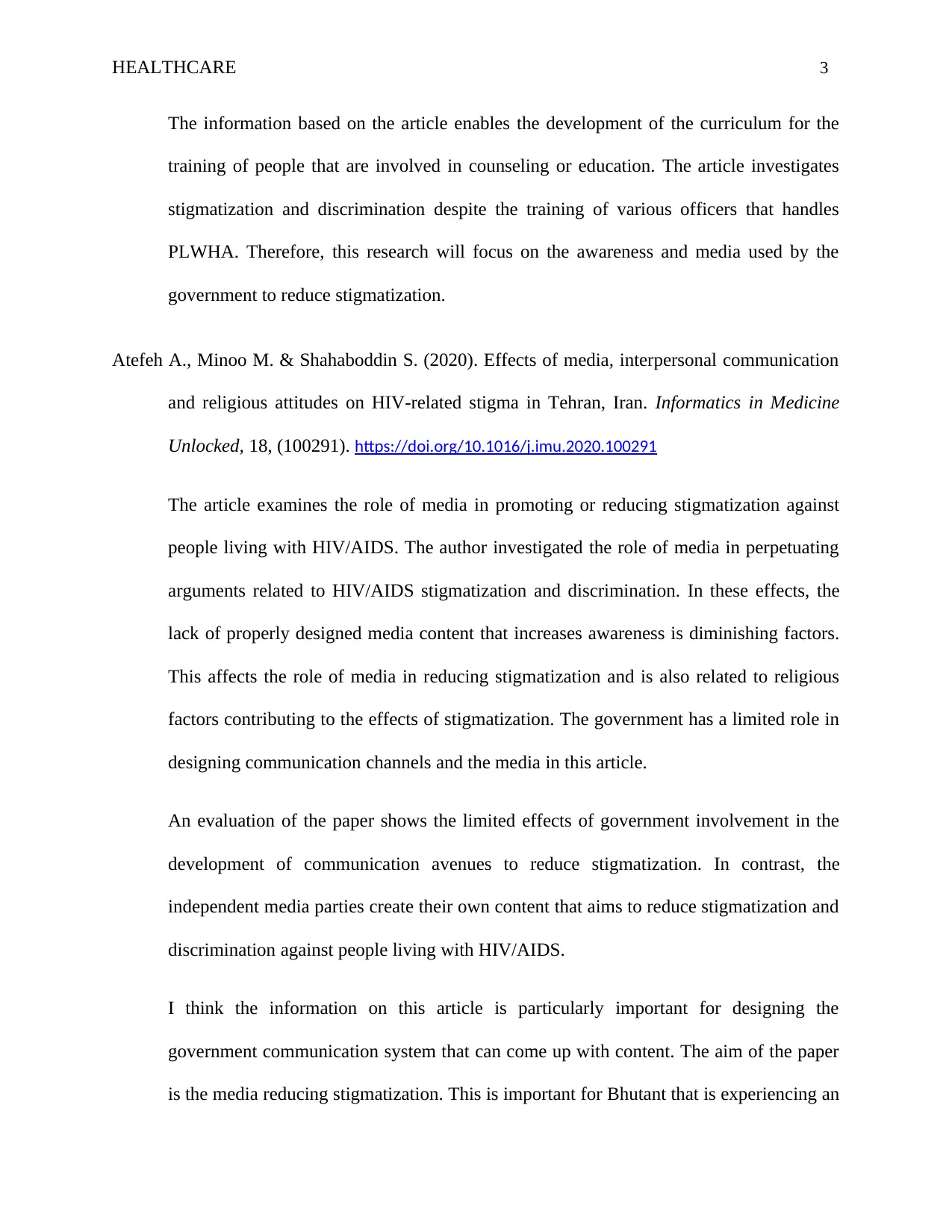
HEALTHCARE 3
The information based on the article enables the development of the curriculum for the
training of people that are involved in counseling or education. The article investigates
stigmatization and discrimination despite the training of various officers that handles
PLWHA. Therefore, this research will focus on the awareness and media used by the
government to reduce stigmatization.
Atefeh A., Minoo M. & Shahaboddin S. (2020). Effects of media, interpersonal communication
and religious attitudes on HIV-related stigma in Tehran, Iran. Informatics in Medicine
Unlocked, 18, (100291). https://doi.org/10.1016/j.imu.2020.100291
The article examines the role of media in promoting or reducing stigmatization against
people living with HIV/AIDS. The author investigated the role of media in perpetuating
arguments related to HIV/AIDS stigmatization and discrimination. In these effects, the
lack of properly designed media content that increases awareness is diminishing factors.
This affects the role of media in reducing stigmatization and is also related to religious
factors contributing to the effects of stigmatization. The government has a limited role in
designing communication channels and the media in this article.
An evaluation of the paper shows the limited effects of government involvement in the
development of communication avenues to reduce stigmatization. In contrast, the
independent media parties create their own content that aims to reduce stigmatization and
discrimination against people living with HIV/AIDS.
I think the information on this article is particularly important for designing the
government communication system that can come up with content. The aim of the paper
is the media reducing stigmatization. This is important for Bhutant that is experiencing an
The information based on the article enables the development of the curriculum for the
training of people that are involved in counseling or education. The article investigates
stigmatization and discrimination despite the training of various officers that handles
PLWHA. Therefore, this research will focus on the awareness and media used by the
government to reduce stigmatization.
Atefeh A., Minoo M. & Shahaboddin S. (2020). Effects of media, interpersonal communication
and religious attitudes on HIV-related stigma in Tehran, Iran. Informatics in Medicine
Unlocked, 18, (100291). https://doi.org/10.1016/j.imu.2020.100291
The article examines the role of media in promoting or reducing stigmatization against
people living with HIV/AIDS. The author investigated the role of media in perpetuating
arguments related to HIV/AIDS stigmatization and discrimination. In these effects, the
lack of properly designed media content that increases awareness is diminishing factors.
This affects the role of media in reducing stigmatization and is also related to religious
factors contributing to the effects of stigmatization. The government has a limited role in
designing communication channels and the media in this article.
An evaluation of the paper shows the limited effects of government involvement in the
development of communication avenues to reduce stigmatization. In contrast, the
independent media parties create their own content that aims to reduce stigmatization and
discrimination against people living with HIV/AIDS.
I think the information on this article is particularly important for designing the
government communication system that can come up with content. The aim of the paper
is the media reducing stigmatization. This is important for Bhutant that is experiencing an
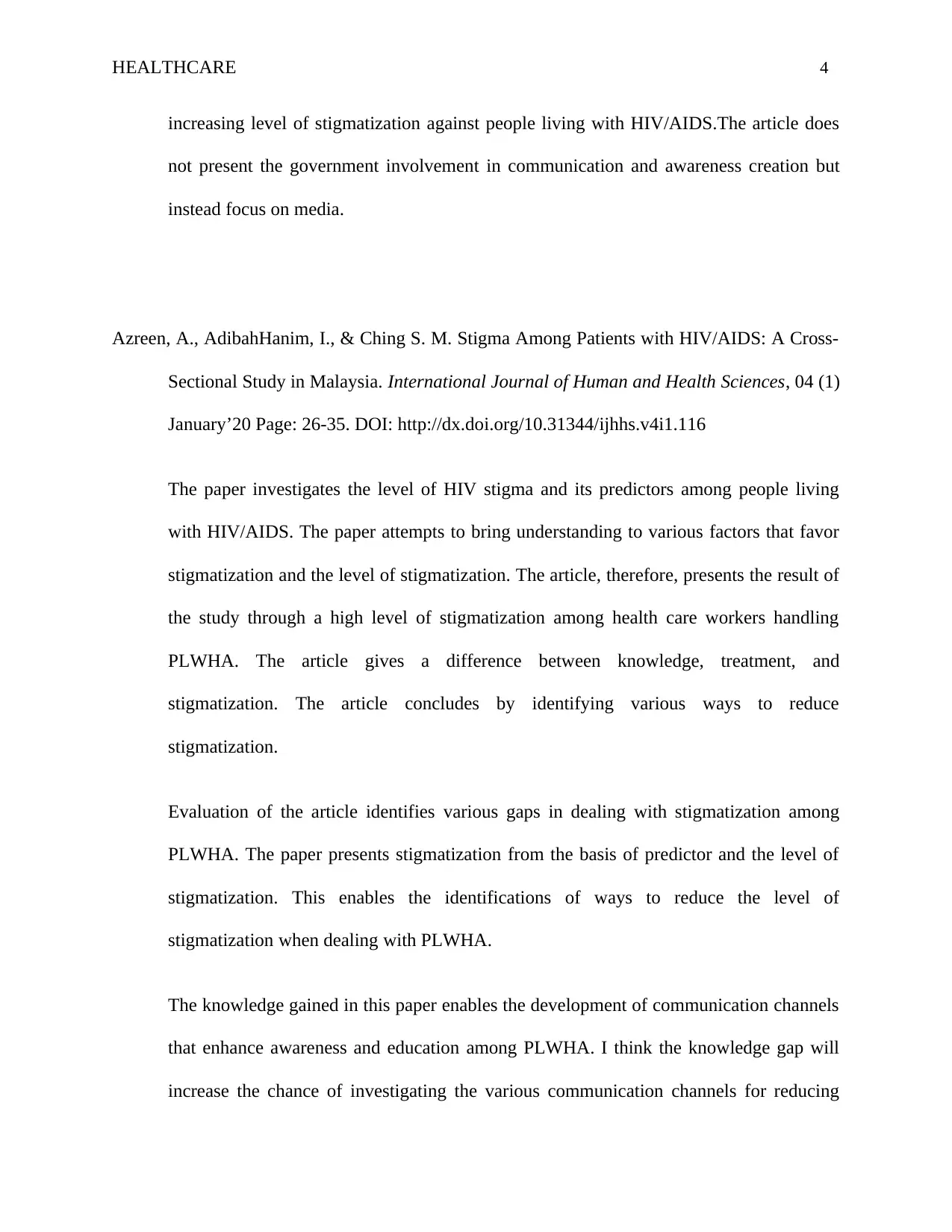
HEALTHCARE 4
increasing level of stigmatization against people living with HIV/AIDS.The article does
not present the government involvement in communication and awareness creation but
instead focus on media.
Azreen, A., AdibahHanim, I., & Ching S. M. Stigma Among Patients with HIV/AIDS: A Cross-
Sectional Study in Malaysia. International Journal of Human and Health Sciences, 04 (1)
January’20 Page: 26-35. DOI: http://dx.doi.org/10.31344/ijhhs.v4i1.116
The paper investigates the level of HIV stigma and its predictors among people living
with HIV/AIDS. The paper attempts to bring understanding to various factors that favor
stigmatization and the level of stigmatization. The article, therefore, presents the result of
the study through a high level of stigmatization among health care workers handling
PLWHA. The article gives a difference between knowledge, treatment, and
stigmatization. The article concludes by identifying various ways to reduce
stigmatization.
Evaluation of the article identifies various gaps in dealing with stigmatization among
PLWHA. The paper presents stigmatization from the basis of predictor and the level of
stigmatization. This enables the identifications of ways to reduce the level of
stigmatization when dealing with PLWHA.
The knowledge gained in this paper enables the development of communication channels
that enhance awareness and education among PLWHA. I think the knowledge gap will
increase the chance of investigating the various communication channels for reducing
increasing level of stigmatization against people living with HIV/AIDS.The article does
not present the government involvement in communication and awareness creation but
instead focus on media.
Azreen, A., AdibahHanim, I., & Ching S. M. Stigma Among Patients with HIV/AIDS: A Cross-
Sectional Study in Malaysia. International Journal of Human and Health Sciences, 04 (1)
January’20 Page: 26-35. DOI: http://dx.doi.org/10.31344/ijhhs.v4i1.116
The paper investigates the level of HIV stigma and its predictors among people living
with HIV/AIDS. The paper attempts to bring understanding to various factors that favor
stigmatization and the level of stigmatization. The article, therefore, presents the result of
the study through a high level of stigmatization among health care workers handling
PLWHA. The article gives a difference between knowledge, treatment, and
stigmatization. The article concludes by identifying various ways to reduce
stigmatization.
Evaluation of the article identifies various gaps in dealing with stigmatization among
PLWHA. The paper presents stigmatization from the basis of predictor and the level of
stigmatization. This enables the identifications of ways to reduce the level of
stigmatization when dealing with PLWHA.
The knowledge gained in this paper enables the development of communication channels
that enhance awareness and education among PLWHA. I think the knowledge gap will
increase the chance of investigating the various communication channels for reducing
Secure Best Marks with AI Grader
Need help grading? Try our AI Grader for instant feedback on your assignments.
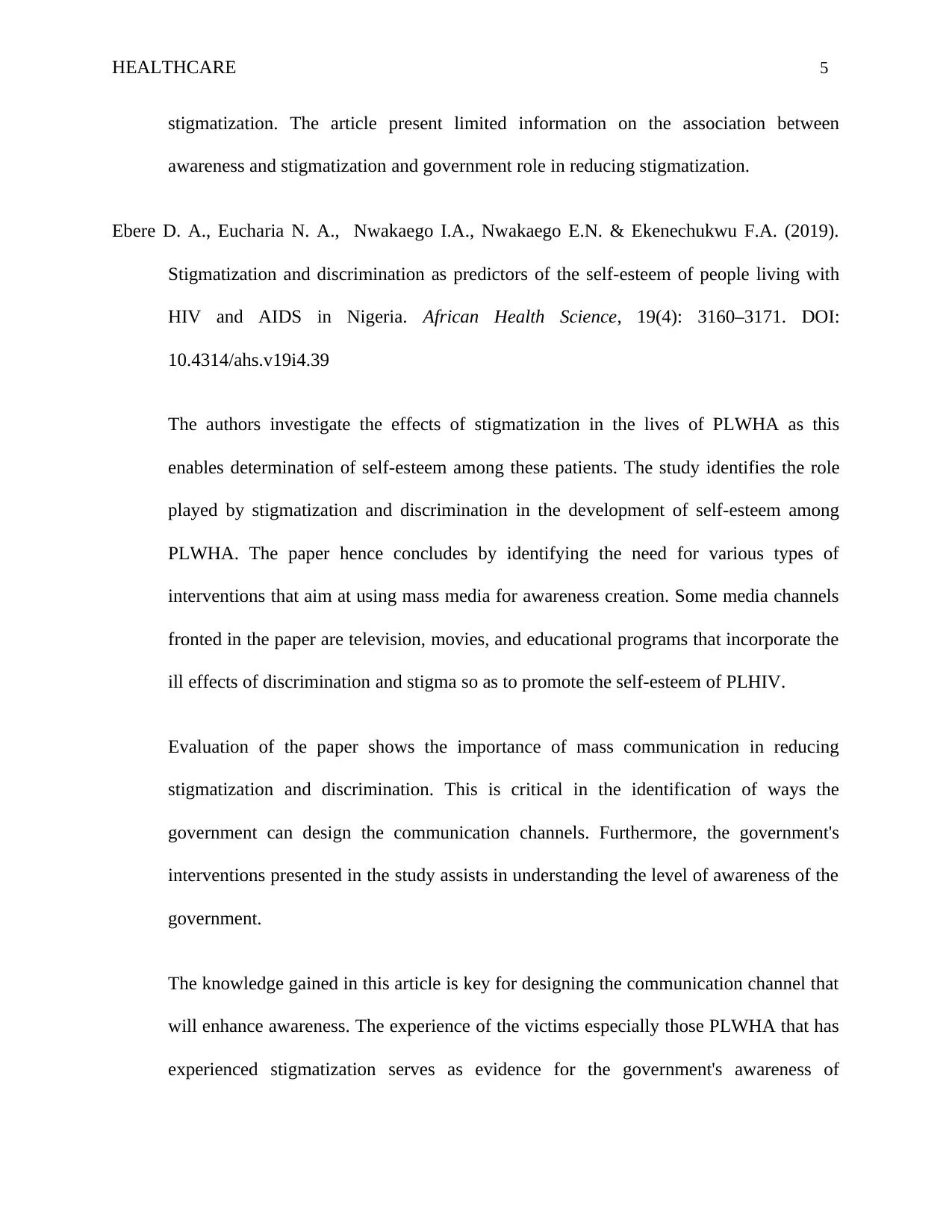
HEALTHCARE 5
stigmatization. The article present limited information on the association between
awareness and stigmatization and government role in reducing stigmatization.
Ebere D. A., Eucharia N. A., Nwakaego I.A., Nwakaego E.N. & Ekenechukwu F.A. (2019).
Stigmatization and discrimination as predictors of the self-esteem of people living with
HIV and AIDS in Nigeria. African Health Science, 19(4): 3160–3171. DOI:
10.4314/ahs.v19i4.39
The authors investigate the effects of stigmatization in the lives of PLWHA as this
enables determination of self-esteem among these patients. The study identifies the role
played by stigmatization and discrimination in the development of self-esteem among
PLWHA. The paper hence concludes by identifying the need for various types of
interventions that aim at using mass media for awareness creation. Some media channels
fronted in the paper are television, movies, and educational programs that incorporate the
ill effects of discrimination and stigma so as to promote the self-esteem of PLHIV.
Evaluation of the paper shows the importance of mass communication in reducing
stigmatization and discrimination. This is critical in the identification of ways the
government can design the communication channels. Furthermore, the government's
interventions presented in the study assists in understanding the level of awareness of the
government.
The knowledge gained in this article is key for designing the communication channel that
will enhance awareness. The experience of the victims especially those PLWHA that has
experienced stigmatization serves as evidence for the government's awareness of
stigmatization. The article present limited information on the association between
awareness and stigmatization and government role in reducing stigmatization.
Ebere D. A., Eucharia N. A., Nwakaego I.A., Nwakaego E.N. & Ekenechukwu F.A. (2019).
Stigmatization and discrimination as predictors of the self-esteem of people living with
HIV and AIDS in Nigeria. African Health Science, 19(4): 3160–3171. DOI:
10.4314/ahs.v19i4.39
The authors investigate the effects of stigmatization in the lives of PLWHA as this
enables determination of self-esteem among these patients. The study identifies the role
played by stigmatization and discrimination in the development of self-esteem among
PLWHA. The paper hence concludes by identifying the need for various types of
interventions that aim at using mass media for awareness creation. Some media channels
fronted in the paper are television, movies, and educational programs that incorporate the
ill effects of discrimination and stigma so as to promote the self-esteem of PLHIV.
Evaluation of the paper shows the importance of mass communication in reducing
stigmatization and discrimination. This is critical in the identification of ways the
government can design the communication channels. Furthermore, the government's
interventions presented in the study assists in understanding the level of awareness of the
government.
The knowledge gained in this article is key for designing the communication channel that
will enhance awareness. The experience of the victims especially those PLWHA that has
experienced stigmatization serves as evidence for the government's awareness of
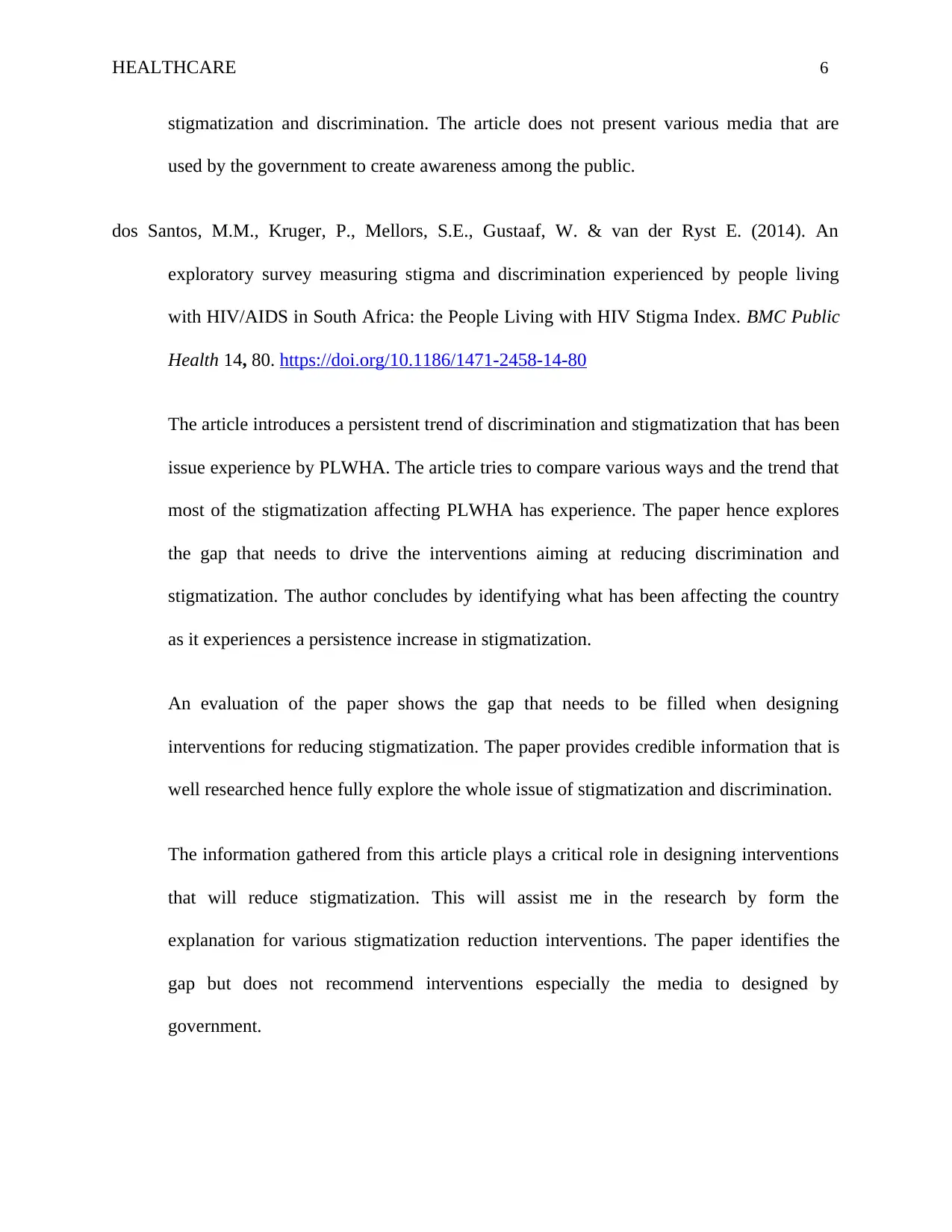
HEALTHCARE 6
stigmatization and discrimination. The article does not present various media that are
used by the government to create awareness among the public.
dos Santos, M.M., Kruger, P., Mellors, S.E., Gustaaf, W. & van der Ryst E. (2014). An
exploratory survey measuring stigma and discrimination experienced by people living
with HIV/AIDS in South Africa: the People Living with HIV Stigma Index. BMC Public
Health 14, 80. https://doi.org/10.1186/1471-2458-14-80
The article introduces a persistent trend of discrimination and stigmatization that has been
issue experience by PLWHA. The article tries to compare various ways and the trend that
most of the stigmatization affecting PLWHA has experience. The paper hence explores
the gap that needs to drive the interventions aiming at reducing discrimination and
stigmatization. The author concludes by identifying what has been affecting the country
as it experiences a persistence increase in stigmatization.
An evaluation of the paper shows the gap that needs to be filled when designing
interventions for reducing stigmatization. The paper provides credible information that is
well researched hence fully explore the whole issue of stigmatization and discrimination.
The information gathered from this article plays a critical role in designing interventions
that will reduce stigmatization. This will assist me in the research by form the
explanation for various stigmatization reduction interventions. The paper identifies the
gap but does not recommend interventions especially the media to designed by
government.
stigmatization and discrimination. The article does not present various media that are
used by the government to create awareness among the public.
dos Santos, M.M., Kruger, P., Mellors, S.E., Gustaaf, W. & van der Ryst E. (2014). An
exploratory survey measuring stigma and discrimination experienced by people living
with HIV/AIDS in South Africa: the People Living with HIV Stigma Index. BMC Public
Health 14, 80. https://doi.org/10.1186/1471-2458-14-80
The article introduces a persistent trend of discrimination and stigmatization that has been
issue experience by PLWHA. The article tries to compare various ways and the trend that
most of the stigmatization affecting PLWHA has experience. The paper hence explores
the gap that needs to drive the interventions aiming at reducing discrimination and
stigmatization. The author concludes by identifying what has been affecting the country
as it experiences a persistence increase in stigmatization.
An evaluation of the paper shows the gap that needs to be filled when designing
interventions for reducing stigmatization. The paper provides credible information that is
well researched hence fully explore the whole issue of stigmatization and discrimination.
The information gathered from this article plays a critical role in designing interventions
that will reduce stigmatization. This will assist me in the research by form the
explanation for various stigmatization reduction interventions. The paper identifies the
gap but does not recommend interventions especially the media to designed by
government.
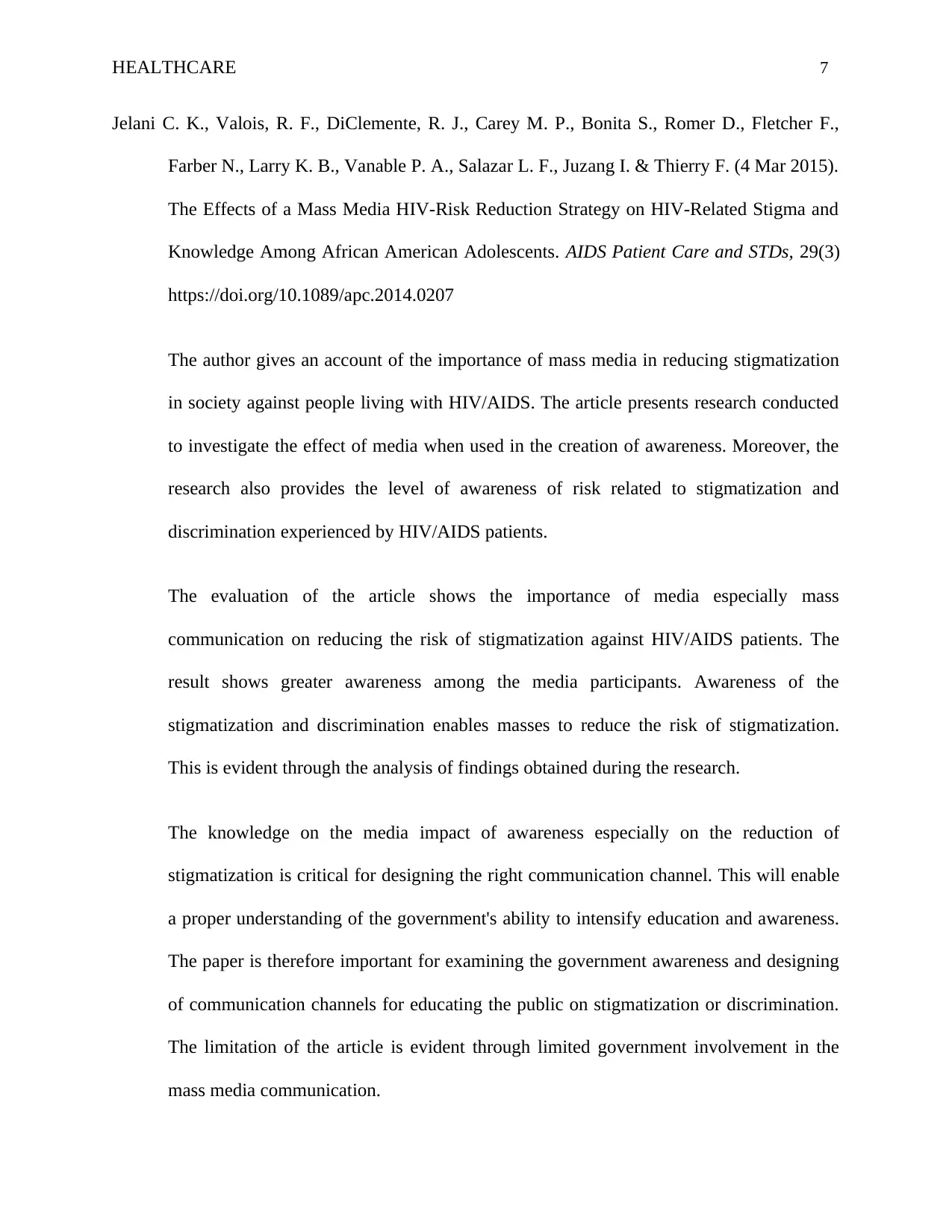
HEALTHCARE 7
Jelani C. K., Valois, R. F., DiClemente, R. J., Carey M. P., Bonita S., Romer D., Fletcher F.,
Farber N., Larry K. B., Vanable P. A., Salazar L. F., Juzang I. & Thierry F. (4 Mar 2015).
The Effects of a Mass Media HIV-Risk Reduction Strategy on HIV-Related Stigma and
Knowledge Among African American Adolescents. AIDS Patient Care and STDs, 29(3)
https://doi.org/10.1089/apc.2014.0207
The author gives an account of the importance of mass media in reducing stigmatization
in society against people living with HIV/AIDS. The article presents research conducted
to investigate the effect of media when used in the creation of awareness. Moreover, the
research also provides the level of awareness of risk related to stigmatization and
discrimination experienced by HIV/AIDS patients.
The evaluation of the article shows the importance of media especially mass
communication on reducing the risk of stigmatization against HIV/AIDS patients. The
result shows greater awareness among the media participants. Awareness of the
stigmatization and discrimination enables masses to reduce the risk of stigmatization.
This is evident through the analysis of findings obtained during the research.
The knowledge on the media impact of awareness especially on the reduction of
stigmatization is critical for designing the right communication channel. This will enable
a proper understanding of the government's ability to intensify education and awareness.
The paper is therefore important for examining the government awareness and designing
of communication channels for educating the public on stigmatization or discrimination.
The limitation of the article is evident through limited government involvement in the
mass media communication.
Jelani C. K., Valois, R. F., DiClemente, R. J., Carey M. P., Bonita S., Romer D., Fletcher F.,
Farber N., Larry K. B., Vanable P. A., Salazar L. F., Juzang I. & Thierry F. (4 Mar 2015).
The Effects of a Mass Media HIV-Risk Reduction Strategy on HIV-Related Stigma and
Knowledge Among African American Adolescents. AIDS Patient Care and STDs, 29(3)
https://doi.org/10.1089/apc.2014.0207
The author gives an account of the importance of mass media in reducing stigmatization
in society against people living with HIV/AIDS. The article presents research conducted
to investigate the effect of media when used in the creation of awareness. Moreover, the
research also provides the level of awareness of risk related to stigmatization and
discrimination experienced by HIV/AIDS patients.
The evaluation of the article shows the importance of media especially mass
communication on reducing the risk of stigmatization against HIV/AIDS patients. The
result shows greater awareness among the media participants. Awareness of the
stigmatization and discrimination enables masses to reduce the risk of stigmatization.
This is evident through the analysis of findings obtained during the research.
The knowledge on the media impact of awareness especially on the reduction of
stigmatization is critical for designing the right communication channel. This will enable
a proper understanding of the government's ability to intensify education and awareness.
The paper is therefore important for examining the government awareness and designing
of communication channels for educating the public on stigmatization or discrimination.
The limitation of the article is evident through limited government involvement in the
mass media communication.
Paraphrase This Document
Need a fresh take? Get an instant paraphrase of this document with our AI Paraphraser
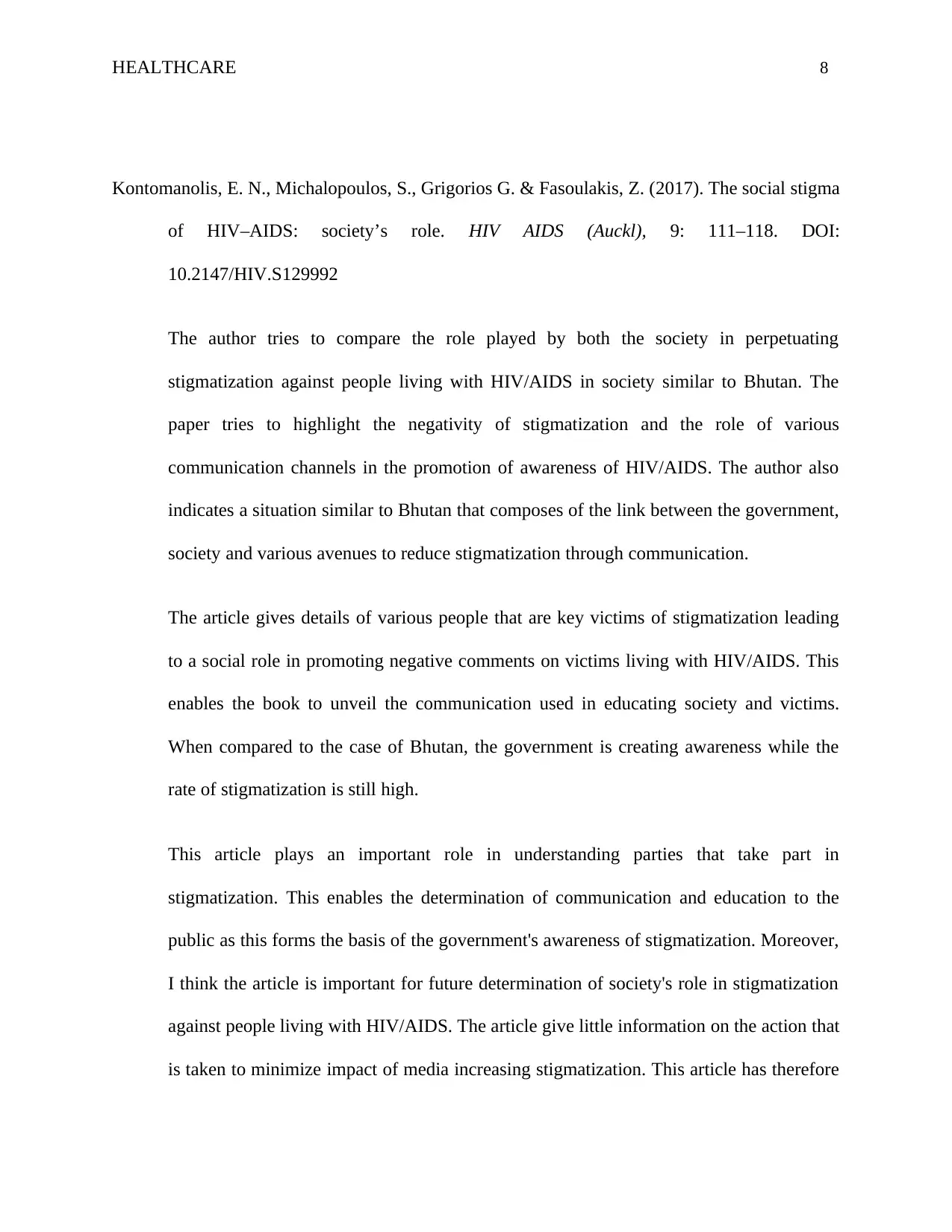
HEALTHCARE 8
Kontomanolis, E. N., Michalopoulos, S., Grigorios G. & Fasoulakis, Z. (2017). The social stigma
of HIV–AIDS: society’s role. HIV AIDS (Auckl), 9: 111–118. DOI:
10.2147/HIV.S129992
The author tries to compare the role played by both the society in perpetuating
stigmatization against people living with HIV/AIDS in society similar to Bhutan. The
paper tries to highlight the negativity of stigmatization and the role of various
communication channels in the promotion of awareness of HIV/AIDS. The author also
indicates a situation similar to Bhutan that composes of the link between the government,
society and various avenues to reduce stigmatization through communication.
The article gives details of various people that are key victims of stigmatization leading
to a social role in promoting negative comments on victims living with HIV/AIDS. This
enables the book to unveil the communication used in educating society and victims.
When compared to the case of Bhutan, the government is creating awareness while the
rate of stigmatization is still high.
This article plays an important role in understanding parties that take part in
stigmatization. This enables the determination of communication and education to the
public as this forms the basis of the government's awareness of stigmatization. Moreover,
I think the article is important for future determination of society's role in stigmatization
against people living with HIV/AIDS. The article give little information on the action that
is taken to minimize impact of media increasing stigmatization. This article has therefore
Kontomanolis, E. N., Michalopoulos, S., Grigorios G. & Fasoulakis, Z. (2017). The social stigma
of HIV–AIDS: society’s role. HIV AIDS (Auckl), 9: 111–118. DOI:
10.2147/HIV.S129992
The author tries to compare the role played by both the society in perpetuating
stigmatization against people living with HIV/AIDS in society similar to Bhutan. The
paper tries to highlight the negativity of stigmatization and the role of various
communication channels in the promotion of awareness of HIV/AIDS. The author also
indicates a situation similar to Bhutan that composes of the link between the government,
society and various avenues to reduce stigmatization through communication.
The article gives details of various people that are key victims of stigmatization leading
to a social role in promoting negative comments on victims living with HIV/AIDS. This
enables the book to unveil the communication used in educating society and victims.
When compared to the case of Bhutan, the government is creating awareness while the
rate of stigmatization is still high.
This article plays an important role in understanding parties that take part in
stigmatization. This enables the determination of communication and education to the
public as this forms the basis of the government's awareness of stigmatization. Moreover,
I think the article is important for future determination of society's role in stigmatization
against people living with HIV/AIDS. The article give little information on the action that
is taken to minimize impact of media increasing stigmatization. This article has therefore
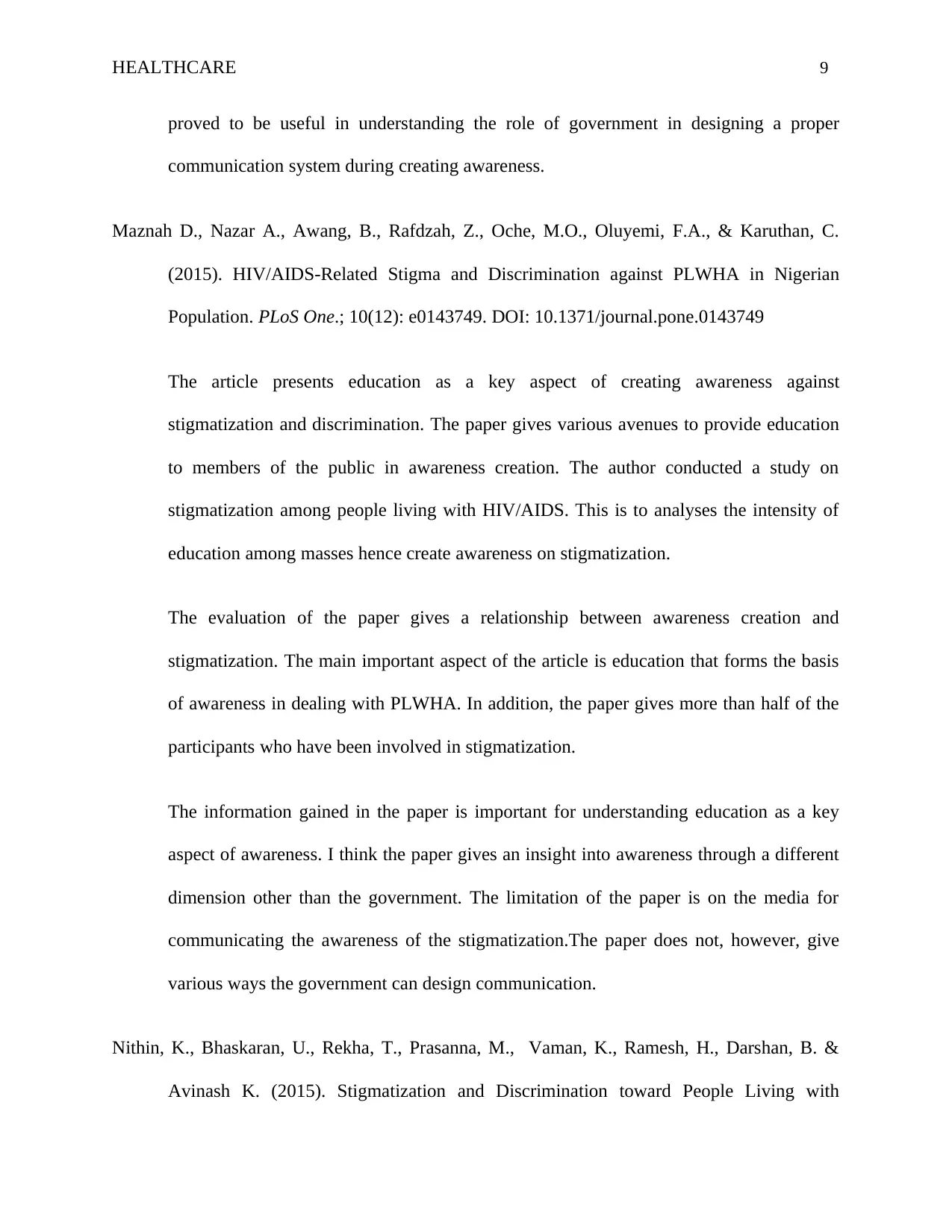
HEALTHCARE 9
proved to be useful in understanding the role of government in designing a proper
communication system during creating awareness.
Maznah D., Nazar A., Awang, B., Rafdzah, Z., Oche, M.O., Oluyemi, F.A., & Karuthan, C.
(2015). HIV/AIDS-Related Stigma and Discrimination against PLWHA in Nigerian
Population. PLoS One.; 10(12): e0143749. DOI: 10.1371/journal.pone.0143749
The article presents education as a key aspect of creating awareness against
stigmatization and discrimination. The paper gives various avenues to provide education
to members of the public in awareness creation. The author conducted a study on
stigmatization among people living with HIV/AIDS. This is to analyses the intensity of
education among masses hence create awareness on stigmatization.
The evaluation of the paper gives a relationship between awareness creation and
stigmatization. The main important aspect of the article is education that forms the basis
of awareness in dealing with PLWHA. In addition, the paper gives more than half of the
participants who have been involved in stigmatization.
The information gained in the paper is important for understanding education as a key
aspect of awareness. I think the paper gives an insight into awareness through a different
dimension other than the government. The limitation of the paper is on the media for
communicating the awareness of the stigmatization.The paper does not, however, give
various ways the government can design communication.
Nithin, K., Bhaskaran, U., Rekha, T., Prasanna, M., Vaman, K., Ramesh, H., Darshan, B. &
Avinash K. (2015). Stigmatization and Discrimination toward People Living with
proved to be useful in understanding the role of government in designing a proper
communication system during creating awareness.
Maznah D., Nazar A., Awang, B., Rafdzah, Z., Oche, M.O., Oluyemi, F.A., & Karuthan, C.
(2015). HIV/AIDS-Related Stigma and Discrimination against PLWHA in Nigerian
Population. PLoS One.; 10(12): e0143749. DOI: 10.1371/journal.pone.0143749
The article presents education as a key aspect of creating awareness against
stigmatization and discrimination. The paper gives various avenues to provide education
to members of the public in awareness creation. The author conducted a study on
stigmatization among people living with HIV/AIDS. This is to analyses the intensity of
education among masses hence create awareness on stigmatization.
The evaluation of the paper gives a relationship between awareness creation and
stigmatization. The main important aspect of the article is education that forms the basis
of awareness in dealing with PLWHA. In addition, the paper gives more than half of the
participants who have been involved in stigmatization.
The information gained in the paper is important for understanding education as a key
aspect of awareness. I think the paper gives an insight into awareness through a different
dimension other than the government. The limitation of the paper is on the media for
communicating the awareness of the stigmatization.The paper does not, however, give
various ways the government can design communication.
Nithin, K., Bhaskaran, U., Rekha, T., Prasanna, M., Vaman, K., Ramesh, H., Darshan, B. &
Avinash K. (2015). Stigmatization and Discrimination toward People Living with
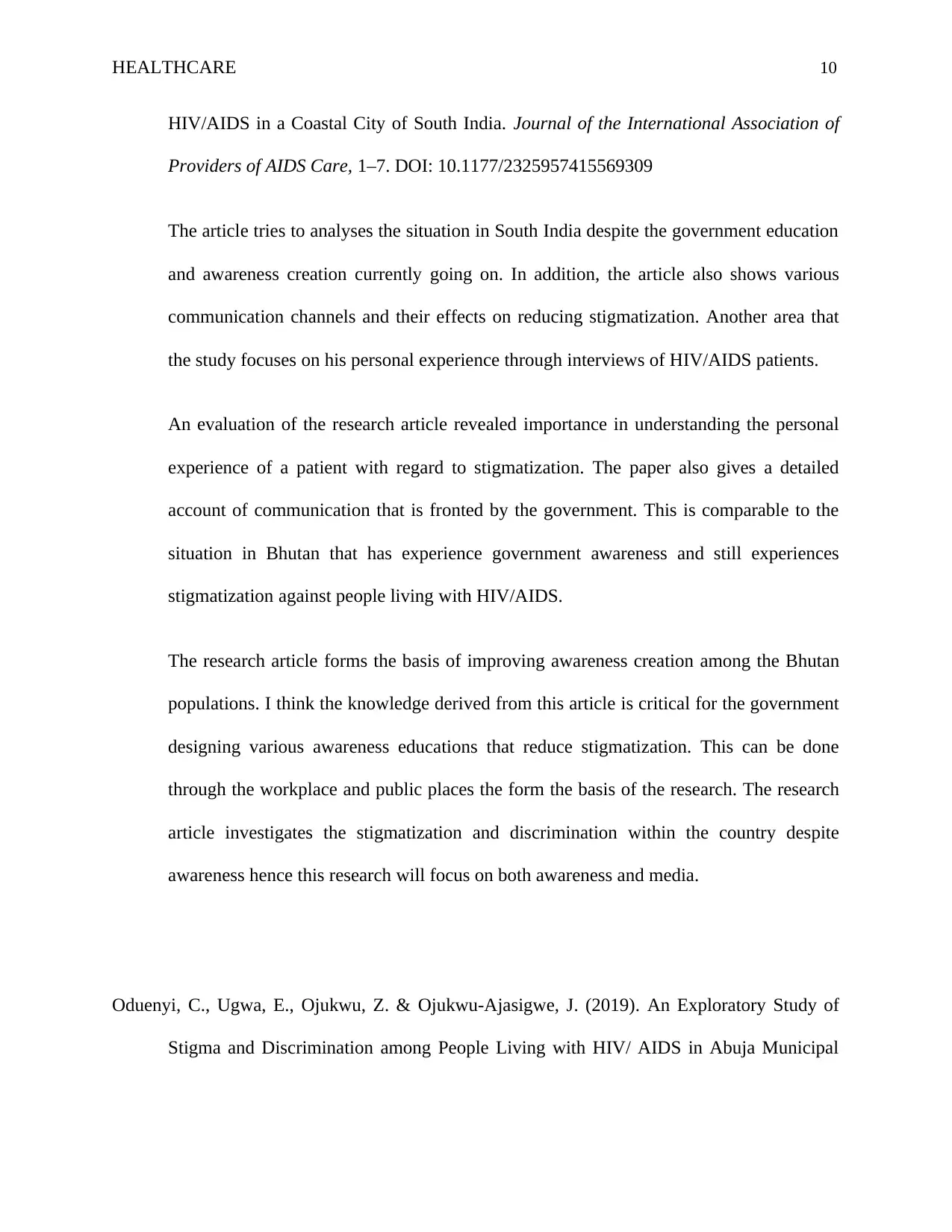
HEALTHCARE 10
HIV/AIDS in a Coastal City of South India. Journal of the International Association of
Providers of AIDS Care, 1–7. DOI: 10.1177/2325957415569309
The article tries to analyses the situation in South India despite the government education
and awareness creation currently going on. In addition, the article also shows various
communication channels and their effects on reducing stigmatization. Another area that
the study focuses on his personal experience through interviews of HIV/AIDS patients.
An evaluation of the research article revealed importance in understanding the personal
experience of a patient with regard to stigmatization. The paper also gives a detailed
account of communication that is fronted by the government. This is comparable to the
situation in Bhutan that has experience government awareness and still experiences
stigmatization against people living with HIV/AIDS.
The research article forms the basis of improving awareness creation among the Bhutan
populations. I think the knowledge derived from this article is critical for the government
designing various awareness educations that reduce stigmatization. This can be done
through the workplace and public places the form the basis of the research. The research
article investigates the stigmatization and discrimination within the country despite
awareness hence this research will focus on both awareness and media.
Oduenyi, C., Ugwa, E., Ojukwu, Z. & Ojukwu-Ajasigwe, J. (2019). An Exploratory Study of
Stigma and Discrimination among People Living with HIV/ AIDS in Abuja Municipal
HIV/AIDS in a Coastal City of South India. Journal of the International Association of
Providers of AIDS Care, 1–7. DOI: 10.1177/2325957415569309
The article tries to analyses the situation in South India despite the government education
and awareness creation currently going on. In addition, the article also shows various
communication channels and their effects on reducing stigmatization. Another area that
the study focuses on his personal experience through interviews of HIV/AIDS patients.
An evaluation of the research article revealed importance in understanding the personal
experience of a patient with regard to stigmatization. The paper also gives a detailed
account of communication that is fronted by the government. This is comparable to the
situation in Bhutan that has experience government awareness and still experiences
stigmatization against people living with HIV/AIDS.
The research article forms the basis of improving awareness creation among the Bhutan
populations. I think the knowledge derived from this article is critical for the government
designing various awareness educations that reduce stigmatization. This can be done
through the workplace and public places the form the basis of the research. The research
article investigates the stigmatization and discrimination within the country despite
awareness hence this research will focus on both awareness and media.
Oduenyi, C., Ugwa, E., Ojukwu, Z. & Ojukwu-Ajasigwe, J. (2019). An Exploratory Study of
Stigma and Discrimination among People Living with HIV/ AIDS in Abuja Municipal
Secure Best Marks with AI Grader
Need help grading? Try our AI Grader for instant feedback on your assignments.
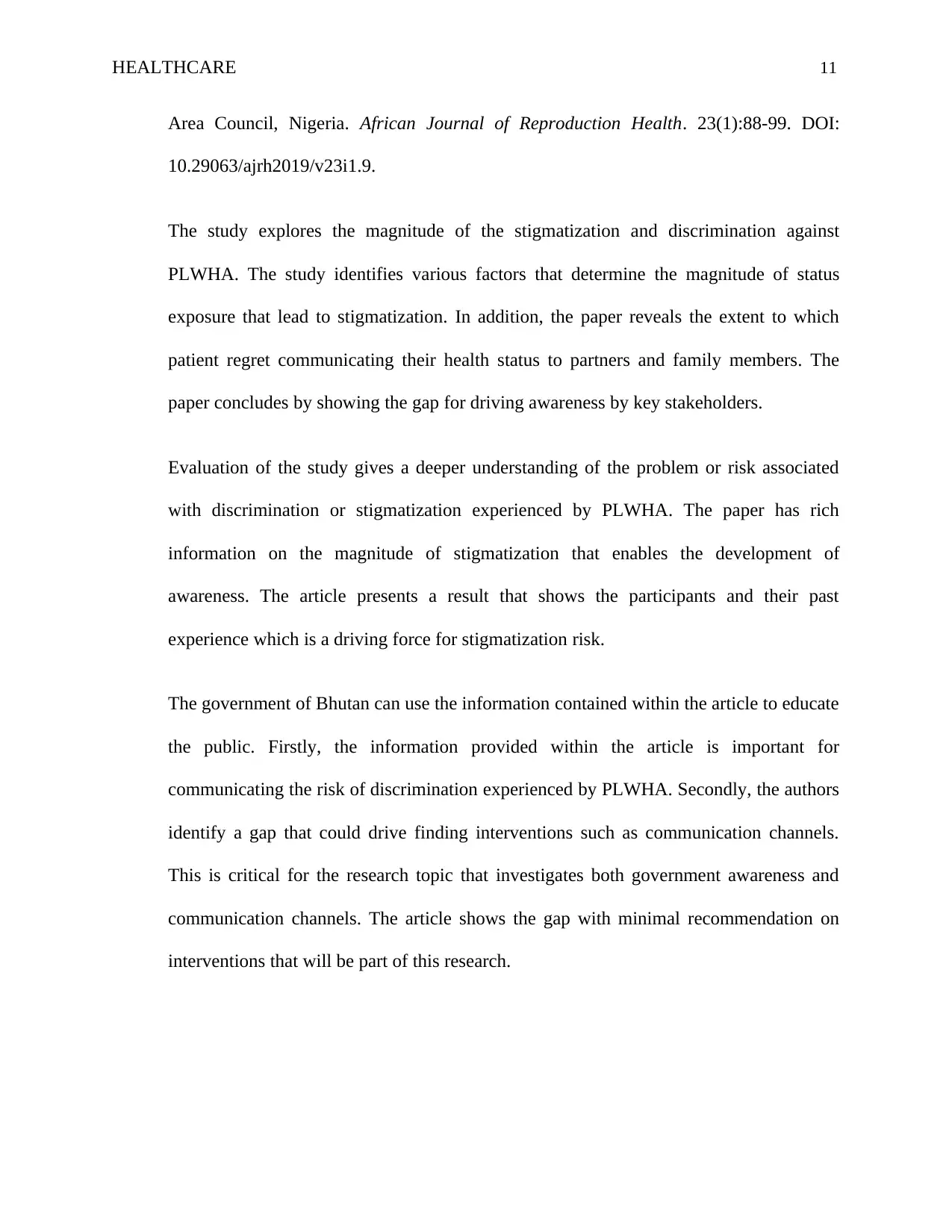
HEALTHCARE 11
Area Council, Nigeria. African Journal of Reproduction Health. 23(1):88-99. DOI:
10.29063/ajrh2019/v23i1.9.
The study explores the magnitude of the stigmatization and discrimination against
PLWHA. The study identifies various factors that determine the magnitude of status
exposure that lead to stigmatization. In addition, the paper reveals the extent to which
patient regret communicating their health status to partners and family members. The
paper concludes by showing the gap for driving awareness by key stakeholders.
Evaluation of the study gives a deeper understanding of the problem or risk associated
with discrimination or stigmatization experienced by PLWHA. The paper has rich
information on the magnitude of stigmatization that enables the development of
awareness. The article presents a result that shows the participants and their past
experience which is a driving force for stigmatization risk.
The government of Bhutan can use the information contained within the article to educate
the public. Firstly, the information provided within the article is important for
communicating the risk of discrimination experienced by PLWHA. Secondly, the authors
identify a gap that could drive finding interventions such as communication channels.
This is critical for the research topic that investigates both government awareness and
communication channels. The article shows the gap with minimal recommendation on
interventions that will be part of this research.
Area Council, Nigeria. African Journal of Reproduction Health. 23(1):88-99. DOI:
10.29063/ajrh2019/v23i1.9.
The study explores the magnitude of the stigmatization and discrimination against
PLWHA. The study identifies various factors that determine the magnitude of status
exposure that lead to stigmatization. In addition, the paper reveals the extent to which
patient regret communicating their health status to partners and family members. The
paper concludes by showing the gap for driving awareness by key stakeholders.
Evaluation of the study gives a deeper understanding of the problem or risk associated
with discrimination or stigmatization experienced by PLWHA. The paper has rich
information on the magnitude of stigmatization that enables the development of
awareness. The article presents a result that shows the participants and their past
experience which is a driving force for stigmatization risk.
The government of Bhutan can use the information contained within the article to educate
the public. Firstly, the information provided within the article is important for
communicating the risk of discrimination experienced by PLWHA. Secondly, the authors
identify a gap that could drive finding interventions such as communication channels.
This is critical for the research topic that investigates both government awareness and
communication channels. The article shows the gap with minimal recommendation on
interventions that will be part of this research.
1 out of 11
Your All-in-One AI-Powered Toolkit for Academic Success.
+13062052269
info@desklib.com
Available 24*7 on WhatsApp / Email
![[object Object]](/_next/static/media/star-bottom.7253800d.svg)
Unlock your academic potential
© 2024 | Zucol Services PVT LTD | All rights reserved.

